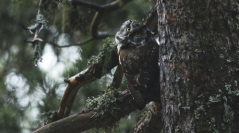

 Naturae
2021 (13) - Pages 167-181
Naturae
2021 (13) - Pages 167-181Small mountain owls (the Tengmalm Owl, Aegolius funereus (Linnaeus, 1758) and the Eurasian Pygmy Owl, Glaucidium passerinum (Linnaeus, 1758)) comprise a few hundred to a few thousand couples in France. Their conservation is at stake regarding their rarity, especially with respect to global change issues. However, their distributions remind little known, especially in the Northern Alps, where presence data are available. Through a collaboration between INRAE, la Ligue pour la Protection des Oiseaux et l’Office national des Forêts, we used occurrence data (2007-2014) to model the distribution of the two species based on six environmental variables that potentially affect their distribution. We showed that the distribution of the two species is mainly driven by elevation and land-use type, while other factors (topography, distance to edges) are less explanatory. These predictions have been used by field naturalists, who structured their field campaigns based on the prediction maps. To continue this research, it seems interesting to extend the approach to other biogeographic contexts and integrate variables that would allow assessing the effects on forest management on these species to the models.